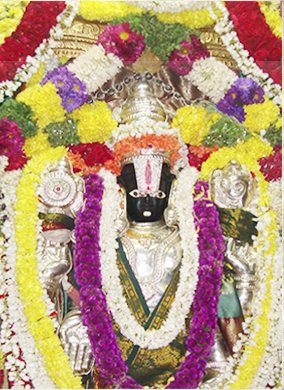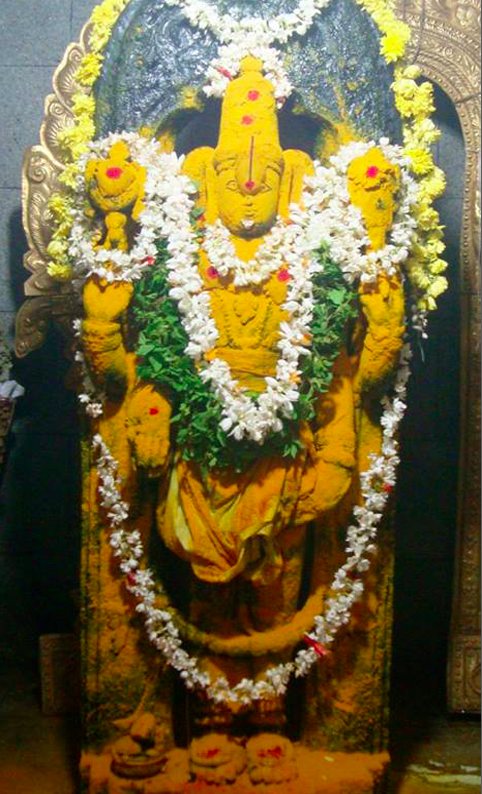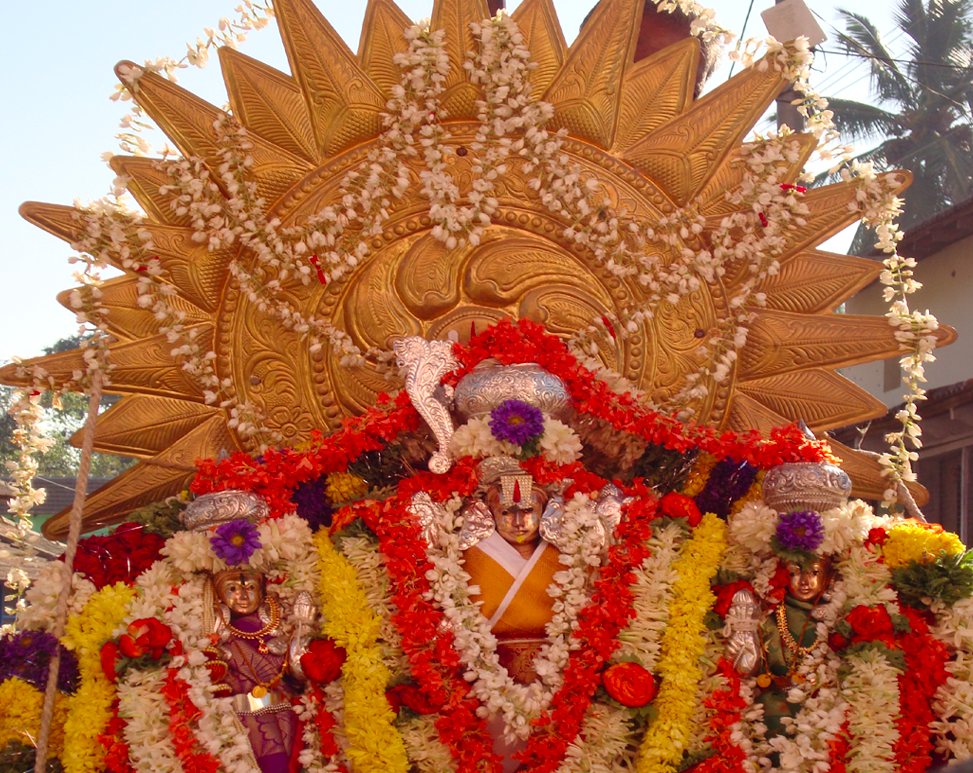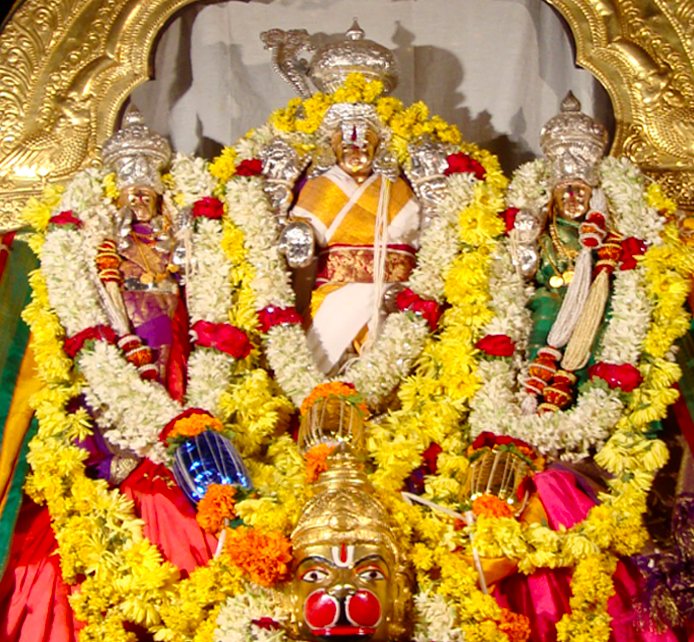Ugane is the originating place of all good deeds, and an ideal place of worship to attain liberation.
Ugane village is located at a distance of about 4 km from Maaranahalli hand post, which is about 15 km from Hassan. Historically, it was known by the name Ujjaini. About 700 to 800 years ago, this village was under the rule of a Chieftain. Even today one can see the ruined forts and bulwarks there, as silent spectators. The vigraham of Lord Soumya Keshava Swamy was installed in the ancient days, the name of which still exists in the revenue records of the Government.
In order to perform the rituals in the temple without any obstacles, some lands were donated by the devotees. Arrangements were made to pay the temple priests, musicians, instrumentalists, servants, etc, from out of the produce got from the lands earmarked in the name of the Temple. This was the arrangement until about 100 years ago.
Period of Nawabs
During the reign of Tippu Sultan, many temples were demolished, looted and most of the wealth was taken away by the rulers which resulted in an unpleasant situation everywhere. The temple of the village was in a dilapidated condition and the temple services were discontinued.
Later on, to carry out their religious rites they brought some SriVaishnavas from the neighboring village named Mugalur, and provided them with all the facilities. Secondly, they needed scholars to carry out their auspicious programs for which, they brought a family of religious scholars. They were also provided with all their needs to live. They were given some properties also.
In the course of time, the Brahmin families multiplied to about 10 to 14 and later became a habitat of about 150 families of all religions. They were all happy and decided to restore the temple which was in a dilapidated condition. The original vigraham of Sri Soumya Keshava Swamy was damaged. Since then the search for a new vigraham began.
Sri Keshava murthy, a School Master, informed that there are a number of vigrahams of Gods and Goddesses in the Hagare Adagur Kashi grove. It was protected by watchmen and covered with bushes, and it was not possible to move the vigrahams in public. By the inspiration of the Lord, Sri Govindachar of Anebagilu house, Raghavachar of Kyathanahalli, Rama Iyengar of lower Street, and Mugalur Rama Iyengar took the bullock cart of Kyathanahalli Raghavachar and headed towards the Kashi Grove on a dark night of Ashada.
There they observed the vigraham in the light of the hurricane lantern. It was drizzling and the bullocks ran away. In spite of such a situation, all the four of them managed to lift the vigraham, loaded it into the cart covered it with straw, and secretly moved it to the village. It was astonishing to see that the vigraham which the four members loaded could not be moved into the temple even with the help of 25 members. In this way the vigraham came into the village.
All the SriVaishnavas met, and after a detailed discussion decided to renovate the temple for which it was decided to collect contributions from devotees. But, this endeavor was stopped due to some obstructions. Later, by the inspiration of the Lord, the deputy commissioner of Hassan district, Sri Balasubramanyam paid a visit to this village. Seeing the state of affairs of the temple, he promised to get the grants from the government for its renovation and obtained 50% of the people’s portion of the expenses. He managed to get the plan and estimates prepared by the engineers, and help completion of the structure with RCC, through a contractor.
The vigraham brought from Kashi Grove was confirmed to be Lord Srinivasa. As this temple belonged to the Department of Charitable Endowments (Muzarai), it was decided to establish the Vigraham of Lord SRINIVASA with the permission of the commissioner of Charitable endowments. The installation of the vigraham of Lord Srinivasa was carried out in the presence of the State Priests and Mulabagilu Sri Venkataramana Dixit by following the Vaikanasagama rituals on an auspicious day in the month of Ashada in 1952.
Sri Narayanachar, a Vaikanasagama pundit (Scholar), was appointed as temple priest, to carry on the day to day rituals of the Lord. Arrangements for supply of Pooja articles, a home to the priest, and attendants with salaries were made. As the temple property was there in existence, Tasdik including daily needs, salaries, expenditure towards Agama were arranged by the Government from the times when Sri Murugendrappa was the Tahsildar.
Developments in later years and Samprokshanam
A committee was formed with Sri. J.Ramaiayangar as the Convener, and Sri Vadyar Ramaswamy Iyengar as Trustee. As things went on, after some years, late Sri Vedanthachar was inspired by the Lord to have Goddess to be prepared for purappadu purposes. The installation of the Gods took place under the guidance of Sri Venkataramana Dixit who had installed the Lord earlier.
Astonished by the developments taking place in the temple, Sri Deshikachar a retired school Master (who is no more) of the neighbouring village Kyathanahalli, expressed his desire to offer a Chariot Service to the Lord according to an inspiration he got in a dream and wished to complete it in his life time, and hence pleaded for the co-operation of the villagers. All the people unanimously agreed to the proposal and the Chariot was ready in about a year and half with the hard work of the skilled workers. The people offered Chariot Service to the Lord and felt immensely satisfied.
The Car Street in the village was encroached and there was no enough space for the Chariot to be taken for the procession. The Tahsildar, Sri Boregowda managed to vacate 100 feet area all around the Temple for this purpose and arranged for suitable wood for the wheels of the Chariot from the neighbouring Thimmanahalli village. In this way, the Convener and the Trustee served for the development of the Temple with the support of the villagers for about 30 to 40 years. They deserve to be remembered at the dawn of every day.
Thereafter, agricultural crops failed due to vagaries of seasons and people became desperate. They moved out to cities in search of jobs and livelihood and the customary rituals gradually faded. The Tasdik from the Department of Charitable Endowments was also stopped. The facilities provided to the temple priests were stopped and the hard days continued until the question of abolition of Tenancy and Inam was decided during the period of the Chief Ministership of Sri Deveraj Urs. Due to lack of maintenance, the roof of the temple cracked, allowing rain water to leak all over the vigraham of the Lord. Herbs and plants grew all around the temple. This state of affairs continued for about 10 to 15 years. The Temple Committee members became old and the support from the devotees became almost nil at this juncture, the youths of the village elected Sri U.R. Radhakrishna as the convener and a new committee was formed on the directions of the convener. The leaking roof was repaired with the co-operation and support from the devotees and the villagers. Roof was put up all around the wall. By this time the Brahmin families rose to about 40. They all became staunch devotees of the Lord. The Car Festival was held with all pomp in the first fortnight of Maagha maasa on the Rathasaptami day of Hindu calendar in accordance with Vaikanasagama Agama rituals with the assistance of the devotees.
In 1996, scholars were invited from far off places. Prof. K.S. Narayana Rao arrived from Dharwad who suggested constructing a Raja Gopuram for the temple. With this suggestion, all the villagers formed a committee, collected contributions from the devotees, and constructed the Raja Gopuram by inviting skilled workers from Tamil Nadu under the supervision of an Engineer Sri K.R.Shrinath with an expense of about Rs 15-20 lakhs within six months at the same time all the villagers joined together and renovated the Hanuman Temple. Kalasha the ornamental top was installed on January 30, 1998 between 12.30 and 1.30 noon in a function arranged under the holy leadership of HH Vageesha Swathantra Parakaala Chief Pontiff Brahmatantra Mahadeshika Mahaswamygalu, Parakaala Matt, Mysore, arranging seven Homakundas and under the chairmanship of Agama Vidhwan Sri Narasimha Murthy Bhat and attended by innumerable devotees. These routine rituals are being carried out even today.
Temple timings:
Morning 7:00-11:00 am
Evening 5:00-8:00 pm
Address and contacts:
Shree Soumya Keshavaswamy Devasthanam
Ugane, Karnataka 573216, India
Mr. ANUP U.S
Koramangala,
Bangalore
Call : 9739179797
Email: usanup.iyengar@gmail.com
Mr. SAMPATH U.K
BTM 1st Stage,
Bangalore
Call :9916585866
Email: sampath.uks@gmail.com
Courtesy: Sri Madhusudhan and uganedevasthanam.com
















Thanks for the post. very interesting to read the history of the temple and place. hope to visit one day to get the Lords blessing. The Idols look very beautiful.
The devotion and involvement of so many bhakthas have saved this temple. Our pranams to all of them. How do we reach this temple? Please guide us.
hi, everyone are welcome to our temple, u can visit our website http://www.uganedevasthanam.com to reach our village. even there is route map in website.
(in simple steps : go to hassan , from there turn to belur road going towards straight u ll get kuppalli , from kuppalli just 1 and halfkm away, u ll get maranahalli post(maranahalli gadi), turn left and go 4 kms, u ll reach the destination.